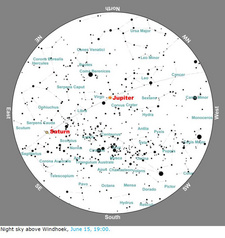In the night sky above Windhoek, Mercury can still be found in the morning houres during the first week of June. Venus rises about three hours before the Sun, therefore it will dominate as brilliant Morning Star. On June, 3, Venus and Uranus are in conjunction in the constellation Pisces. As Uranus will be bright enough to be spotted in a dark area of Namibia without light pollution, it might be worth to look at this interesting combination of these two planets.
Mars will slowly approach solar conjunction towards July, 27, therefore it is rather difficult to spot it in the strong evening twilight before setting. Rather try to observe Jupiter which sets shortly after midnight and can be observed as sparkling Evening Star. Also worthwhile to look at – on June, 4, Jupiter is close to the Moon.
Moon Phases in Namibia:
First Quarter June, 1
Full Moon June, 8
Last Quarter June, 17
New Moon June, 24
Canis Major will descend in the south east while Sagittarius will rise in the east. Ursa Major will descend in the north east. Southern Cross will reach its highest position above the horizon. Conjunction is the close alignment in the sky of two or more celestial bodies, which occurs when they lie in the same direction as viewed from our plant, the Earth. When a planet lies directly on the opposite side of the Sun as seen from Earth, it is said to be at superior conjunction. When either Venus or Mercury are passing between Earth and the Sun, the planet is said is said to be at inferior conjunction. Opposition means when Mars or one of the giant planets lie on the exact opposite side of the Earth from the Sun and at its highest position in the night sky at midnight. Then the planet is closest to the Earth and appears at it brightest. Did you know? Spacecraft on their way to the outer giant gas planets took a few images of asteroids when they were crossing the Main Belt. Recently, dedicated space craft were sent to specific asteroids and have been placed into orbit with them. When crossing the Main Belt on its way to Jupiter, the well-known Galileo space craft passed two asteroids, namely Gaspra and Ida. Both of them have a smooth and cratered surface, having been sandblasted by the impact of countless smaller bodies in their region. Gaspra has been found to rotate within seven hours and is made of solid rock. Ida spins a bit faster in a period of 4.6 hours. Very interesting about Ida is the fact that it has a small companion. Moon Dactyl has a diameter of only 1.4 km and Ida was the very first asteroid to be found with a satellite. To date, the most successful mission to an asteroid has been NEAR Shoemaker (NEAR stands for Near Earth Asteroid Rendezvous). Launched in early 1986, the craft flew past Mathilde and then, after four years after leaving Earth, was placed into orbit around Eros. This irregular shaped asteroid is made of silicate rock and is the second largest near Earth. Eros’s path takes it across that of Mars, while it will probably crosses Earth’s orbit in about 2 million years. Many asteroids have derived their names from persons, activities or organisations linked to astronomy. Two of these celestial bodies were named after South Africans, while another one of them got named after an astronomical society in the Western Cape. The first one is Shuttleworth, named after Mark Shuttleworth, the South African born business man, who was the first citizen of the African continent to venture into space on a Soyus mission during 2002. The next one is Hermanus, named in recognition of the Hermanus Astronomy Centre’s enthusiasm for astronomy and their enormous dedication to educational training in this field. Last but not least – Timothycooper, named after Timothy Cooper, a South African astronomer for his leading role in publishing and coordinating results of local observations made in South Africa, including detailed observational results of meteors and more specifically bolides. (A bolide is an extremely bright meteor, especially one that explodes in Earth’s atmosphere. It refers to a huge fire ball as bright as a Full Moon.)
In Verbindung stehende Artikel

